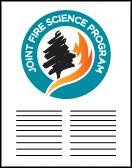United States Joint Fire Science Program
Document Type
Article
Date of this Version
2009
Citation
Foltz, Randy B.; Robichaud, Peter R.; Rhee, Hakjun. 200 . A synthesis of postfire road treatments for BAER teams: methods, treatment effectiveness, and decisionmaking tools for rehabilitation. Gen. Tech. Rep. RMRS-GTR-228 Fort Collins, CO: U.S. Department of Agriculture, Forest Service, Rocky Mountain Research Station. 152 p.
Abstract
We synthesized post-fire road treatment information to assist BAER specialists in making road rehabilitation decisions. We developed a questionnaire; conducted 30 interviews of BAER team engineers and hydrologists; acquired and analyzed gray literature and other relevant publications; and reviewed road rehabilitation procedures and analysis tools. Post-fire road treatments are implemented if the values at risk warrant the treatment and based on regional characteristics, including the timing of first damaging storm and window of implementation. Post-fire peak flow estimation is important when selecting road treatments. Interview results indicate that USGS methods are used for larger watersheds (>5 mi2) and NRCS Curve Number methods are used for smaller watersheds (<5 mi2). These methods are not parameterized and validated for post-fire conditions. Many BAER team members used their own rules to determine parameter values for USGS regression and NRCS CN methods; therefore, there is no consistent way to estimate postfire peak flow. Many BAER road treatments for individual stream crossings were prescribed based on road/culvert surveys, without considering capacities of existing road structure and increased post-fire peak flow. For all regions, rolling dips/water bars, culvert upgrading, and ditch cleaning/armoring are the most frequently used road treatments. For Forest Service Regions 1 and 4, culvert upgrading is preferred, especially for fish-bearing streams. For Forest Service Region 3, culvert removal with temporary road closure and warning signs is preferred. Except for culverts, insufficient data is available on other road treatments to estimate their capacity and to evaluate their effectiveness.
Included in
Forest Biology Commons, Forest Management Commons, Natural Resources and Conservation Commons, Natural Resources Management and Policy Commons, Other Environmental Sciences Commons, Other Forestry and Forest Sciences Commons, Sustainability Commons, Wood Science and Pulp, Paper Technology Commons



Comments
US government work.